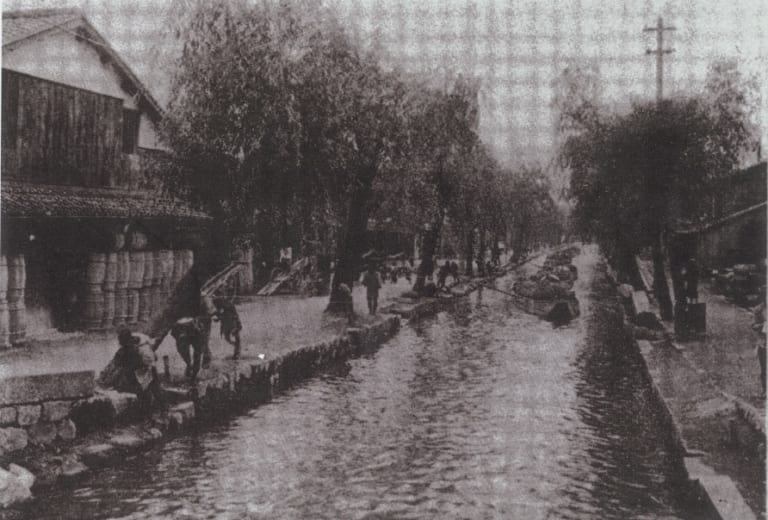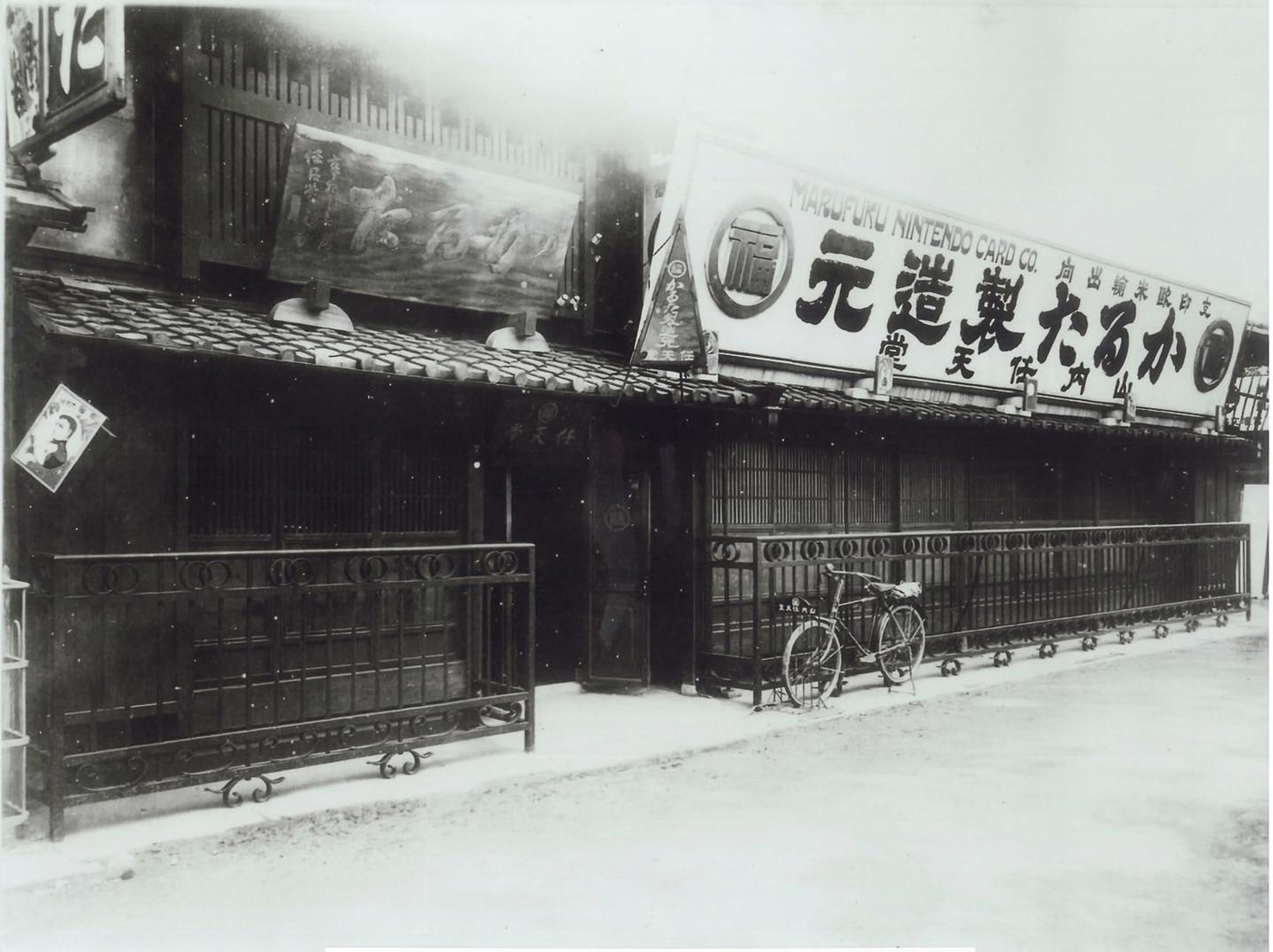Fusajiro Yamauchi on:
[Wikipedia]
[Google]
[Amazon]
, originally born as , was a Japanese entrepreneur who founded Yamauchi Nintendo, later known as

 In 1890, Nintendo expands its products and starts selling
In 1890, Nintendo expands its products and starts selling
Nintendo
is a Japanese Multinational corporation, multinational video game company headquartered in Kyoto. It develops, publishes, and releases both video games and video game consoles.
The history of Nintendo began when craftsman Fusajiro Yamauchi ...
. Yamauchi lived in Kyoto, Japan
Kyoto ( or ; Japanese: , ''Kyōto'' ), officially , is the capital city of Kyoto Prefecture in the Kansai region of Japan's largest and most populous island of Honshu. , the city had a population of 1.46 million, making it the ninth-most pop ...
and had a wife and two daughters—one of whom was Tei Yamauchi, who later married Sekiryō Kaneda, the successor and second president of Nintendo.
Early life
Fusajirō Fukui was born on November 22, 1859, as the oldest son of Sōsuke Fukui, a craftsperson. Fusajirō took the name Yamauchi after anarranged marriage
Arranged marriage is a type of Marriage, marital union where the bride and groom are primarily selected by individuals other than the couple themselves, particularly by family members such as the parents. In some cultures, a professional matchmaki ...
with one of the daughters of the Yamauchi family, who owned a company named Haigan dealing with lime. Since the Yamauchi family had no male heirs to inherit the company, Fusajirō was adopted by the Yamauchis and became the heir to his adoptive father, Naoshichi Yamauchi.
Shortly after, in 1885, Fusajirō inherited the company at the age of 17 and renamed it Haikyō.

Yamauchi Fusajirō Shōten or Yamauchi Nintendo
In the context of theMeiji Restoration
The , referred to at the time as the , and also known as the Meiji Renovation, Revolution, Regeneration, Reform, or Renewal, was a political event that restored Imperial House of Japan, imperial rule to Japan in 1868 under Emperor Meiji. Althoug ...
, in 1885, gambling laws were relaxed in Japan, and Hanafuda
() are a type of Japanese playing cards. They are typically smaller than Western playing cards, only , but thicker and stiffer. On the face of each card is a depiction of plants, , animals, birds, or man-made objects. One single card depicts a ...
cards, which were previously banned, became legal. Fusajiro, after having opened other shops selling lime in Kyoto, was inspired by both the booming business of Hanafuda
() are a type of Japanese playing cards. They are typically smaller than Western playing cards, only , but thicker and stiffer. On the face of each card is a depiction of plants, , animals, birds, or man-made objects. One single card depicts a ...
and his personal taste for the game. He played it regularly and decided to use his skills as a craftsperson to open a factory building handmade Hanafuda decks.
On September 23, 1889, Fusajiro Yamauchi opened Yamauchi Fusajirō Shōten, also known as Yamauchi Nintendo (other sources also mention the name Nintendo Koppai), at the location of an unoccupied house he had purchased. Fusajiro crafted the Hanafuda decks using mulberry
''Morus'', a genus of flowering plants in the family Moraceae, consists of 19 species of deciduous trees commonly known as mulberries, growing wild and under cultivation in many temperate world regions. Generally, the genus has 64 subordinat ...
bark, clay and a wood-block printing machine that he designed himself. The Hanafuda decks sold by Nintendo, known as Daitōryō (i.e President) decks, were recognizable thanks to the illustration of Napoleon
Napoleon Bonaparte (born Napoleone di Buonaparte; 15 August 1769 – 5 May 1821), later known by his regnal name Napoleon I, was a French general and statesman who rose to prominence during the French Revolution and led Military career ...
that adorned them and became highly successful in Kyoto
Kyoto ( or ; Japanese language, Japanese: , ''Kyōto'' ), officially , is the capital city of Kyoto Prefecture in the Kansai region of Japan's largest and most populous island of Honshu. , the city had a population of 1.46 million, making it t ...
within a few years.
 In 1890, Nintendo expands its products and starts selling
In 1890, Nintendo expands its products and starts selling Uta-garuta
is a type of a deck of ''karuta'', Japanese traditional playing cards. A set of ''uta-garuta'' contains two sets of 100 cards, with a '' waka'' poem written on each. ''Uta-garuta'' is also the name of the game in which the deck is used. The st ...
decks. However, it soon faced challenges in selling its Hanafuda and Uta-garuta due to competition and a shrinking market in its vicinity. Fusajiro then had the idea of using the Hanafuda cards of lesser quality that had been discarded and selling them in new decks called "Tengu", which were priced lower than the Daitōryō decks. Additionally, Fusajiro decided to target the clubhouse market. These places never used the same deck twice to prevent cheating, resulting in high deck turnover. In the end, Fusajiro managed to secure contracts with around 70 clubhouses, each using at least 50 decks per night.
Nintendo and trump cards
Just as Hanafuda cards were allowed again in 1885, so too did occidental playing cards (theStandard 52-card deck
The standard 52-card deck of French-suited playing cards is the most common pack of playing cards used today. The main feature of most playing card decks that empower their use in diverse games and other activities is their double-sided design, w ...
) become allowed. These western cards, called ‘Trump’ by the Japanese population, truly began to achieve success in 1886. It was by witnessing their popularity and recognizing that they were primarily purchased by the wealthy upper class due to their high prices from exportation that Fusajiro had the idea to produce his own Trump cards instead of importing them.
Although 1907 is most commonly cited as the date when Nintendo started selling their own manufactured western playing cards, a 1974 presentation flyer by the company cites 1911 as the year when trump decks started being made. Moreover, Nintendo's website lists 1902 as the year "Mr. Yamauchi started manufacturing the first western-style playing cards in Japan." According to author Florent Gorges, the date 1902 comes from the website of Watada Insatsujo (Watada Printings), a printing company that still works with Nintendo today and has done so since 1899. Indeed, on their website, it is written (translated): "1902: Beginning of the prints of "Trump" playing cards for Nintendo Koppai."
The decision by Fusajiro to start selling western playing cards made in Japan happened at a fortuitous time for Nintendo. In the same year, the imperial government implemented a new tax on mah-jong and cards producers called the "Koppai Zei" or "Karuta Zei". This tax of 20 sen, created to prepare for future armed conflicts (the sen is a subdivision of the Japanese yen
The is the official currency of Japan. It is the third-most traded currency in the foreign exchange market, after the United States dollar and the euro. It is also widely used as a third reserve currency after the US dollar and the euro.
Th ...
, which became obsolete in 1954), doubled the price of most Hanafuda decks. These decks were also sold for around 20 sen, leading to more than half of the main producers of Hanafuda cards closing their shops. The western cards served as a lifeline for Nintendo, which was the only company selling these made-in-Japan western cards at the time.
Distribution across Japan
Limited to theOsaka
is a Cities designated by government ordinance of Japan, designated city in the Kansai region of Honshu in Japan. It is the capital of and most populous city in Osaka Prefecture, and the List of cities in Japan, third-most populous city in J ...
and Kyoto
Kyoto ( or ; Japanese language, Japanese: , ''Kyōto'' ), officially , is the capital city of Kyoto Prefecture in the Kansai region of Japan's largest and most populous island of Honshu. , the city had a population of 1.46 million, making it t ...
region, Fusajiro had the idea to create a distribution network to expand Nintendo’s operations throughout all of Japan. This was something unheard of at the time, as only drugs and tobacco possessed that kind of distribution.
And so, in 1907, Fusajiro expanded Nintendo’s operations by making a deal with Nihon Senbai (now Japan Tobacco
The (JT) is a Japanese diversified tobacco company and parent company to Japan Tobacco International, one of the three largest international Big Tobacco product manufacturers in the world. It was established in 1985 as a that inherited the ri ...
) to sell Nintendo cards in cigarette shops throughout all of Japan. By the time of Fusajiro’s retirement in 1929, Nintendo had become the largest playing-card company in Japan.
Personal details
Without a son, Fusajiro decided to arrange a marriage in 1905 between Sekiryō Kaneda, an employee who started working at Nintendo at the beginning of the decade, and one of his two daughters, Tei. Over the next decades, Sekiryō would lead both the Nintendo and Haikyō companies alongside his stepfather until 1929, the year in which Fusajiro retired, and Sekiryō Yamauchi inherited both companies.Notes
References
{{DEFAULTSORT:Yamauchi, Fusajiro 1868 births 1929 deaths 19th-century Japanese businesspeople 20th-century Japanese businesspeople Nintendo people